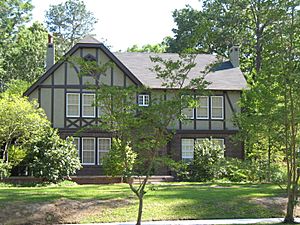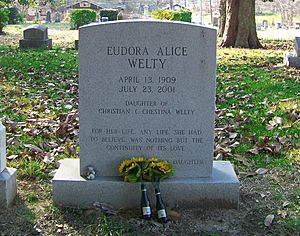Eudora Welty facts for kids
Quick facts for kids
Eudora Welty
|
|
|---|---|

Eudora Welty in 1962
|
|
| Born |
Eudora Alice Welty
April 13, 1909 Jackson, Mississippi, U.S.
|
| Died | July 23, 2001 (aged 92) Jackson, Mississippi, U.S.
|
| Nationality | American |
| Occupation | Author, photographer |
| Awards | Edward MacDowell Medal 1970 Pulitzer Prize for Fiction 1973 The Optimist's Daughter National Book Award for Fiction 1983 The Collected Stories of Eudora Welty |
Eudora Alice Welty (born April 13, 1909 – died July 23, 2001) was an American writer and photographer. She was famous for her short stories and novels about the American South. Her novel The Optimist's Daughter won the important Pulitzer Prize in 1973.
Eudora Welty received many awards, including the Presidential Medal of Freedom. She was also the first living author to have her books published by the Library of America, which collects important American writings. Her home in Jackson, Mississippi is now a National Historic Landmark and a museum that people can visit.
Contents
Eudora Welty's Life Story
Eudora Welty was born in Jackson, Mississippi, on April 13, 1909. Her parents were Christian Webb Welty and Mary Chestina Welty. She grew up with her two younger brothers. Her mother was a schoolteacher who loved reading, and she taught Eudora to love books too. Eudora's father worked in insurance and was interested in machines and gadgets. He inspired Eudora's interest in technology and photography.
Eudora went to Central High School in Jackson. After high school, her family moved to a new house at 1119 Pinehurst Street. This house stayed her home for the rest of her life. Today, it is known as the Eudora Welty House and Garden.
Welty studied at the Mississippi State College for Women from 1925 to 1927. Then, she moved to the University of Wisconsin to finish her studies in English literature. Her father suggested she also study advertising at Columbia University. However, it was during the Great Depression, so it was hard for her to find a job in New York.
When Eudora returned to Jackson in 1931, her father passed away. She found a job at a local radio station and wrote about society in Jackson for a newspaper. In 1933, she started working for the Works Progress Administration (WPA). This government program helped people find jobs during the Great Depression. As a publicity agent, she collected stories, did interviews, and took photos of daily life in Mississippi. This job helped her learn a lot about life in the South and the people there, which she later used in her stories. During this time, she also had meetings at her house with other writers and friends. They called themselves the Night-Blooming Cereus Club. After three years, she left her job to become a full-time writer.
In 1936, she published her first short story, "The Death of a Traveling Salesman." Soon, her stories appeared in famous magazines like The New Yorker. She became a well-known Southern writer when she published her first book of short stories, A Curtain of Green. Her success led her to work for The New York Times Book Review. She also received a Guggenheim Fellowship, which allowed her to travel to Europe. She even lectured at Oxford and Cambridge universities, becoming the first woman allowed into the hall of Peterhouse College. In 1960, she returned home to Jackson to care for her mother and brothers.
After a significant event in Mississippi in 1963, she wrote a story called "Where Is the Voice Coming From?" It was published in The New Yorker.
In 1971, she published a collection of her photographs from the Great Depression, called One Time, One Place. Two years later, she won the Pulitzer Prize for Fiction for her novel The Optimist's Daughter. She gave talks at Harvard University, which she later turned into a three-part memoir called One Writer's Beginnings. She lived in her family home in Jackson until she passed away on July 23, 2001. She is buried in Greenwood Cemetery in Jackson. Her headstone has a quote from The Optimist's Daughter: "For her life, any life, she had to believe, was nothing but the continuity of its love."
Eudora Welty's Photography
While Eudora Welty worked for the Works Progress Administration (WPA), she spent her free time taking pictures of people from all walks of life. Her photos from the early 1930s show the poor people in rural Mississippi and how the Great Depression affected them.
Collections of her photographs were published in books like One Time, One Place (1971) and Photographs (1989). Her photography even inspired some of her short stories. For example, "Why I Live at the P.O." was inspired by a woman she photographed ironing in a small post office. Even though she focused on writing, Welty continued to take photos until the 1950s.
Eudora Welty's Writing Career
Eudora Welty's first short story, "Death of a Traveling Salesman," was published in 1936. Her work caught the attention of author Katherine Anne Porter, who became her mentor. Porter wrote the introduction for Welty's first collection of short stories, A Curtain of Green, in 1941. This book made Welty one of America's most important writers. It included famous stories like "Why I Live at the P.O.," "Petrified Man," and "A Worn Path." Welty wrote over forty short stories, five novels, three non-fiction books, and one children's book.
Her short story "Why I Live at the P.O." was published in 1941. It was later included in A Curtain of Green. The story is about a character named Sister who moves out of her family's home to live at the post office where she works. Critics saw it as a great example of Southern writing. The story humorously shows family relationships. Like many of her stories, Welty was skilled at capturing the way people spoke in the South and showing the importance of location and local customs. "A Worn Path" was also published in A Curtain of Green and is considered one of her best short stories. It won an award in 1941.
Welty's first novel, The Robber Bridegroom (1942), was different from her earlier works. It was written in a fairy-tale style. Most critics and readers saw it as a modern Southern fairy tale, similar to stories by the Brothers Grimm.
After a difficult event in Mississippi in 1963, Welty wrote Where Is the Voice Coming From?. She later said she wanted to understand the person involved in such an event. She wrote the story from that character's point of view. Welty's story was published in The New Yorker soon after an arrest was made.
The Optimist's Daughter (1972) won the Pulitzer Prize for Fiction and is thought by some to be Welty's best novel. It was written much later in her career. The story is about family challenges when a daughter and her father's second wife meet in a hospital room.
Welty gave a series of talks at Harvard University, which were later published as One Writer's Beginnings (1983). This book became a New York Times Best Seller and was nominated for a National Book Award.
In 1992, she received the Rea Award for the Short Story for her amazing contributions to American short stories. Welty was also a founding member of the Fellowship of Southern Writers in 1987. She taught creative writing at colleges and workshops. She lived near Belhaven College in Jackson and was a familiar face in her hometown.
Welty also helped inspire several young writers from Mississippi, including Richard Ford and Elizabeth Spencer.
What Eudora Welty Wrote About
Eudora Welty was a very productive writer who wrote in many different styles. In her writing, you can often find repeated ideas like the interesting ways people relate to each other, the importance of the place where a story happens (a common idea in Southern writing), and how old myths and stories influence her themes.
Welty said that she was interested in how people connect with their communities because she was a good observer. You can see this clearly in the short stories in A Curtain of Green. For example, "Why I Live at the P.O." humorously shows the conflict between Sister and her family. This story uses a lack of good communication to show the deeper idea of how human connections can be tricky. Another example is Miss Eckhart in The Golden Apples, who is seen as an outsider in her town. Welty shows that this piano teacher's independent life allows her to follow her dreams, but also highlights Miss Eckhart's wish to have a family and feel like she belongs in the community. Her stories often show characters trying to keep their own identity while still being part of a group.
The setting, or "place," is very important to Welty. She believed that the place is what makes a story feel real because it brings with it customs, feelings, and memories. Place helps answer questions like, "What happened? Who's here? Who's coming?" Place helps us remember things, and it's the human mind that makes a place meaningful. This is the job of a storyteller. "A Worn Path" is a short story that shows how the setting shapes how we understand the tale. In the story, the main character, Phoenix, has to overcome challenges in the detailed Southern landscape as she travels to the nearest town. "The Wide Net" is another of Welty's short stories that uses place to create the mood and plot. The river in the story is seen differently by each character. Some see it as a source of food, others see it as dangerous, and some see it as a sign that "the outside world is full of endurance."
Welty is also known for using ideas from mythology to connect her characters and places to bigger, universal truths. You can find examples in the short story "A Worn Path," the novel Delta Wedding, and the collection of short stories The Golden Apples. In "A Worn Path," the character Phoenix has a lot in common with the mythical bird. Phoenixes are known for their strength and dignity. Phoenix, the old Black woman, is described as wearing a red scarf with hints of gold, and she is noble and strong in her difficult journey to get medicine for her grandson.
Awards and Honors
Eudora Welty received many awards for her writing:
- 1941: O. Henry Award, second place, "A Worn Path"
- 1942: O. Henry Award, first place, "The Wide Net"
- 1943: O. Henry Award, first place, "Livvie is Back"
- 1954: William Dean Howells medal for fiction, The Ponder Heart
- 1968: O. Henry Award, first place, "The Demonstrators”
- 1969: Fellow of the American Academy of Arts and Sciences
- 1970: The Edward MacDowell Medal
- 1973: Pulitzer Prize for Fiction, The Optimist's Daughter
- 1980: Presidential Medal of Freedom
- 1983: National Book Award for The Collected Works of Eudora Welty
- 1983: Invited by Harvard University to give special lectures, which became One Writer's Beginnings
- 1985: Achievement Award, American Association of University Women
- 1986: National Medal of Arts
- 1991: National Book Foundation Medal for Distinguished Contribution to American Letters
- 1992: Rea Award for the Short Story
- 1992: PEN/Malamud Award for the Short Story
- 1993: Charles Frankel Prize, National Endowment for the Humanities
- 1996: Made a Chevalier de la Légion d’honneur by the French government
- 1998: First living author to have her works published in the prestigious Library of America series
- 2000: America Award for her lifetime contribution to international writing
- 2000: Induction into the National Women's Hall of Fame
Remembering Eudora Welty
- In 1990, Steve Dorner named his e-mail program "Eudora" after Welty's story "Why I Live at the P.O." Welty was reportedly "pleased and amused" by this tribute.
- In 1973, the state of Mississippi declared May 2 as "Eudora Welty Day."
- Each October, Mississippi University for Women hosts the "Eudora Welty Writers' Symposium" to celebrate the work of modern Southern writers.
- A portrait of Eudora Welty hangs in the National Portrait Gallery of the Smithsonian. It was painted by her friend Mildred Nungester Wolfe.
- On September 10, 2018, Eudora Welty became the first author honored with a historical marker through the Mississippi Writers Trail. This marker was placed at the Eudora Welty House and Garden in Jackson, Mississippi.
Eudora Welty's Books
Short Story Collections
- A Curtain of Green, 1941
- The Wide Net and Other Stories, 1943
- The Golden Apples, 1949
- The Bride of the Innisfallen and Other Stories, 1955
- Thirteen Stories, 1965
- The Collected Stories of Eudora Welty, 1980
- Moon Lake and Other Stories, 1980
- Morgana: Two Stories from The Golden Apples, 1988
Novels
- The Robber Bridegroom (a shorter novel), 1942
- Delta Wedding, 1946
- The Ponder Heart, 1954
- The Shoe Bird (for young readers), 1964
- Losing Battles, 1970
- The Optimist's Daughter, 1972
Essays and Non-Fiction
- The Eye of the Story, 1979
- One Writer's Beginnings, 1984
- On Writing, 2002
See also
 In Spanish: Eudora Welty para niños
In Spanish: Eudora Welty para niños




